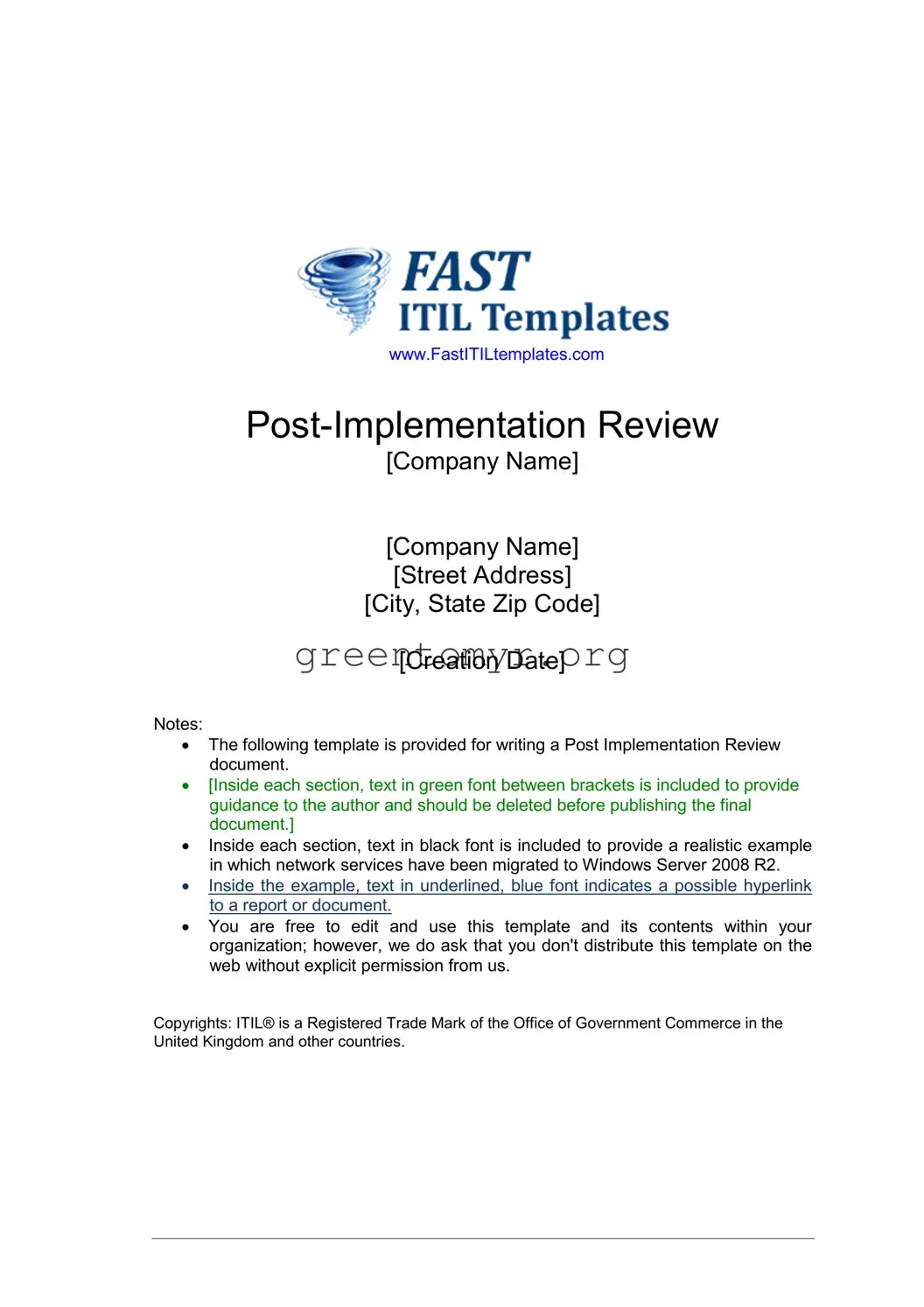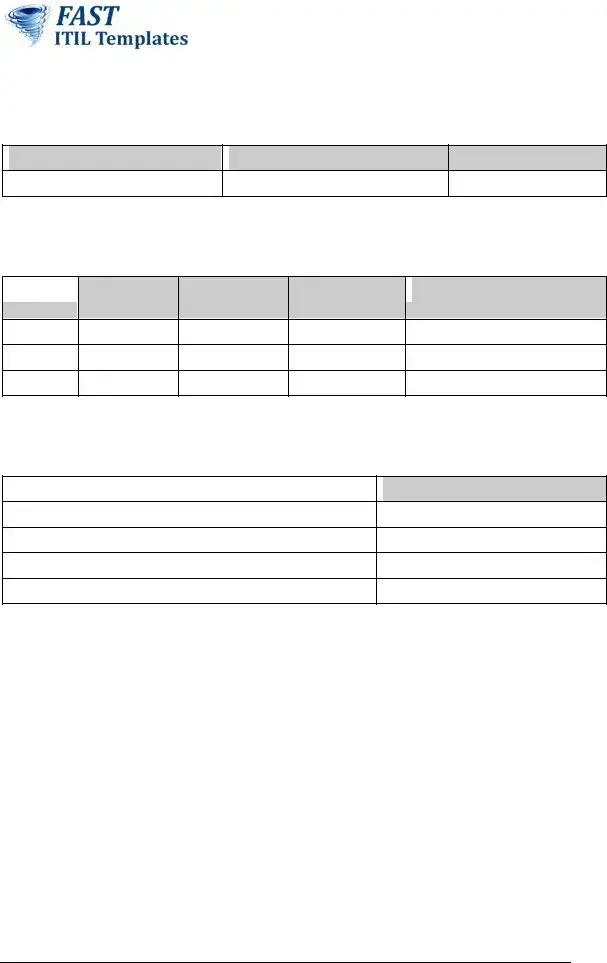www.FastITILtemplates.com
Post-Implementation Review
[Company Name]
[Company Name]
[Street Address]
[City, State Zip Code]
[Creation Date]
Notes:
•The following template is provided for writing a Post Implementation Review document.
•[Inside each section, text in green font between brackets is included to provide guidance to the author and should be deleted before publishing the final document.]
•Inside each section, text in black font is included to provide a realistic example in which network services have been migrated to Windows Server 2008 R2.
•Inside the example, text in underlined, blue font indicates a possible hyperlink to a report or document.
•You are free to edit and use this template and its contents within your organization; however, we do ask that you don't distribute this template on the web without explicit permission from us.
Copyrights: ITIL® is a Registered Trade Mark of the Office of Government Commerce in the United Kingdom and other countries.
www.FastITILtemplates.com |
Post-Implementation Review |
|
|
Document Control
Preparation
 Action
Action
Release
 Name
Name
 Title
Title
|
www.FastITILtemplates.com |
Post-Implementation Review |
|
|
Table of Contents |
|
1. |
EXECUTIVE SUMMARY |
4 |
2. |
INTRODUCTION |
5 |
2.1 |
Background |
5 |
2.2 |
Objectives |
5 |
2.3 |
Scope |
6 |
2.4 |
Post-Implementation Review Team Members |
6 |
3. |
FINDINGS |
8 |
3.1 |
Accomplishment of project goals |
................................................................................................ |
8 |
3.2 |
Performance Metrics |
9 |
3.3 |
Side-effects |
9 |
3.4 |
Residual risks |
10 |
3.5 |
Cost |
10 |
3.6 |
Schedule |
11 |
3.7 |
Customers and Users Satisfaction |
12 |
4. |
CONCLUSION |
13 |
4.1 |
Lessons Learned |
13 |
4.2 |
Recommendations |
14 |
5. |
ANNEX |
15 |
5.1 |
Glossary |
15 |
5.2 |
List of Tables |
16 |
5.3 |
References |
17 |
Page 3
www.FastITILtemplates.com |
Post-Implementation Review |
|
|
1.Executive Summary
[Write a brief summary of the content of the Post-Implementation Review. The executive summary is produced for business purposes, with the objective that an executive can read it and understand the message without having to read the whole document.
Use concise language, summarizing ideas in the same order that they appear in the detailed contents. The summary must be able to be read separately from the rest of the document and transmit the message.]
This document is a report with the findings of the Post-Implementation Review that has been conducted to evaluate the results of the project to migrate the server infrastructure of the organization to Windows Server 2008 R2. The high- level goals of the project were to reduce IT costs, simplify management, improve security and increase application performance.
From the findings, the conclusions obtained have been:
1.Accomplishment of project goals: The stated initial goals have been accomplished.
2.Performance metrics: The implementation has solved the problems that previously existed with some of the performance indicators. As a result, all of the KPI are in agreement with the SLA.
3.Side-effects: Under the new architecture, the proprietary client-server application that manages the Customer Relationship Management (CRM) of the organization is sometimes freezing. A workaround has been implemented to temporarily manage the resulting incidents.
4.Residual risks: The predicted risks have been effectively managed.
5.Costs: Costs slightly exceeded predictions due to delays in one step of the implementation.
6.Schedule: Delays in the deployment phase were caused by a failure in Supply Management to engage appropriately a third party supplier responsible for servers.
7.Customers and users satisfaction: Customers and clients satisfaction with the migration and with the final outcome is at acceptable levels.
The following recommendations arise from this report:
1.Raise a Request for Comments (RFC) and generate a problem ticket to resolve the incompatibility in the proprietary client-server application.
2.Service Level Management and Supply Management must revise underpinning contracts to further support the objectives of the services.
3.The Configuration Management Database (CMDB) must be revised to update all the relevant dependencies between Configuration Items.
4.Project procedures should be improved to further diminish the impact of the transition on users.
Page 4
www.FastITILtemplates.com |
Post-Implementation Review |
|
|
2.Introduction
[The Post-Implementation Review report is a document intended to capture the results of an ITIL Post-Implementation Review. The Post-Implementation Review is aimed at determining to what extent a change or project has been successful, and to identify opportunities for improvement.
In this section you explain the background, objectives, scope of the Post- Implementation Review, and members of the team who executed the review.]
2.1Background
[Expose the background to this change/project, including why it was launched and how it was implemented. You can also explain how the Post-Implementation Review was conducted and how its results are feeding this report.]
After an extensive analysis of benefits and cons was conducted, a decision was taken to migrate all the infrastructure servers in the organization to Windows Server 2008 R2. Some of the benefits expected were:
•Reduce costs through efficient virtualization and less power consumption.
•Simplify Management.
•Improve Security.
•Increase application performance through new architectures.
At that time, most of the servers in the organization were based in Windows Server 2003 and Windows Server 2008. Virtualization was not still implemented although several proposals were made calling to virtualize either using Hyper-V from Microsoft or ESX from VMWare. The approved project called for a phased migration of all Microsoft servers to Windows Server 2008 R2 and the implementation of a Hyper-V solution.
After successful implementation of the project, a Post-Implementation Review was conducted to evaluate results six months after successful migration. The findings from this review are documented in the current document.
2.2Objectives
[An ITIL Post-Implementation Review is performed to confirm that the change/project has met the stated objectives; that customers, users and stakeholders are happy with the results; and that there have been no unexpected side-effects. It is also an important tool to correct course if needed and to improve the change/project process in future recurrences.]
The objectives of this Post-Implementation Review have been:
•Demonstrate that the project has achieved its objectives and the proposals in the business case.
•Check if customers, users and stakeholders are satisfied with the outcomes.
Page 5
www.FastITILtemplates.com |
Post-Implementation Review |
|
|
•Deal with unexpected and/or undesirable side-effects.
•Help to decide if any corrective action is needed.
•Learn lessons to improve future changes/projects implementation.
2.3Scope
[Explain here which elements of a review have been included and which others have been excluded. Some of the elements to define the scope may be:
•Change/project has accomplished the desired objectives.
•Users, customers and other stakeholders are satisfied with the outcomes.
•There are no unexpected or undesirable side-effects to functionality and service levels.
•The resources used to implement the change were as planned.
•The release and deployment plan worked correctly.
•The change was implemented on time and to cost.
•The remediation plan functioned correctly, if needed.
.]
This document reviews the results of the implementation of the project “Migration to a Windows Server 2008 R2 infrastructure”. The elements included in the review have been:
•Accomplishment of project goals.
•Performance metrics.
•Side-effects.
•Residual risks.
•Costs.
•Schedules.
•Users and customers satisfaction.
This document does not include:
•Remediation’s plan effectiveness, because its activation was not needed.
2.4Post-Implementation Review Team Members
[Include here the members of the team who conducted the Post-Implementation Review. If possible, members of the Post-Implementation Review Team should not have participated in the actual implementation of the change/project, although people who defined the original requirements or gave technical advice could be included. They should have been selected as impartial reviewers without any interest or benefit in the positive or negative outcome of the review.]
The personnel that participated in the Post-Implementation Review are shown in Table 1. Post-Implementation Review Team Members, below:
Name  Position
Position
Page 6
www.FastITILtemplates.com |
Post-Implementation Review |
|
|
John Doe
Jane Doe
Jane Smith
John Smith
Post-Implementation Review Chief
Change Analyst
Business Relationship Analyst
Senior User
Table 1. Post-Implementation Review Team Members.
Page 7
www.FastITILtemplates.com |
Post-Implementation Review |
|
|
3.Findings
[The central part of the Post-Implementation Review is to compare the original goals of the change/project with the achieved outcomes and then learn any lessons from results to improve the success of future changes/projects. Comparisons are to be held following the scopes defined in the section 2.3 above. Select subsections in your document accordingly]
3.1Accomplishment of Project Goals
[Determine whether the implemented system has achieved its proposed outcome and has provided the desired benefits in support of the mission and goals.]
To measure effectively the intended benefits of the project against the actual outcome, several Key Performance Indicators (KPI's) and measurements were previously defined. The results are shown in the Table 2. Initial, Projected and Real Outcomes of the Migration.
Objective |
|
Initial |
|
Projected |
|
Outcome |
|
Deviation |
Reduce costs |
|
$ 504.8 /day |
|
$401 /day |
|
$400.9 /day |
- $0.1 |
in Datacenter |
|
|
|
|
|
|
|
/day |
through |
|
|
|
|
|
|
|
|
efficient |
|
|
|
|
|
|
|
|
virtualization |
|
|
|
|
|
|
|
|
|
|
|
|
|
|
|
|
|
Less power |
|
56 KWh /day |
|
32.8 KWh |
|
32.9 KWh |
|
+0.1 KWh /day |
consumption |
|
|
|
/day |
|
/day |
|
|
in the |
|
|
|
|
|
|
|
|
Datacenter |
|
|
|
|
|
|
|
|
|
|
|
|
|
|
|
|
|
Simplify |
|
2.5 h /1000 |
|
1.5 h /1000 |
|
1.1 h /1000 |
|
- 0.4 h /1000 |
Management |
|
users/day |
|
users/day |
|
users/day |
|
users/day |
|
|
|
|
|
Improve |
0.067 |
0.010 |
0.0055 |
- 0.0045 |
Security |
|
incidents /day |
|
incidents /day |
|
incidents /day |
|
incidents /day |
|
|
|
|
|
|
|
|
|
Increase |
|
0.1 s |
|
0.65 s |
|
0.55 s |
|
-0.1 s |
application |
|
/transaction |
|
/transaction |
|
/transaction |
|
/transaction |
performance |
|
|
|
|
|
|
|
|
through new |
|
|
|
|
|
|
|
|
architectures |
|
|
|
|
|
|
|
|
|
|
|
|
|
|
|
|
|
Table 2. Initial, Projected and Real Outcomes of the Migration.
The deviations observed in each of the defined key indicators are within the accepted ranges as defined in the design of the project.
The indicator of security improvement may appear to indicate an over- investment because measurement is far better than predicted. This behavior is expected and is the result of the adoption of strictest controls through Federation Services in a parallel project.
Page 8
www.FastITILtemplates.com |
Post-Implementation Review |
|
|
3.2Performance Metrics
[Check that the system turns to be or continues to be fit for purpose as defined in the ITIL Service Level Agreement, Contract or other agreements. Metrics can describe performance factors like availability, capacity, continuity or security.
Provide metrics for as much areas as can be affected by the change/project.]
To ensure the stability of the network services provided after the project, the main KPIs from the Service Level Agreement (SLA) were selected to check their behavior before and after the implementation of the migration project. Results are shown in the Table 3. Performance Metrics.
Metric |
|
SLA |
|
|
Initial |
|
Final |
|
Status |
Percent of |
95 |
|
96.5 |
96.5 |
|
In compliance |
Directory |
|
|
|
|
|
|
|
|
|
access within |
|
|
|
|
|
|
|
|
|
agreed |
|
|
|
|
|
|
|
|
|
response time |
|
|
|
|
|
|
|
|
|
|
|
|
|
|
|
|
Percent of |
95 |
|
91.2 |
96.2 |
|
In compliance, |
Web access |
|
|
|
|
|
|
|
|
improved, |
within agreed |
|
|
|
|
|
|
|
|
problem solved |
response time |
|
|
|
|
|
|
|
|
|
|
|
|
|
|
|
|
Incidents |
95 |
|
97.8 |
97.6 |
|
In compliance |
solved within |
|
|
|
|
|
|
|
|
|
agreed time |
|
|
|
|
|
|
|
|
|
|
|
|
|
|
|
|
Availability of |
99.5 |
|
99.29 |
99.99 |
|
In compliance, |
network |
|
|
|
|
|
|
|
|
improved, |
services |
|
|
|
|
|
|
|
|
problem solved |
|
|
|
|
|
|
|
|
|
|
|
Table 3. Performance Metrics |
|
|
Results show that stability of the system has been guaranteed after the migration and even improved. Some important problems were also solved as a result. Previous breaches in Web access services were solved through migration of servers to 64-bit architecture. General availability was also improved thanks to the implementation of Live-Migration techniques.
Time to solve incidents slightly deteriorate at first as a result of the learning curve, but later has been improving.
3.3Side-Effects
[Explain unexpected or undesired side-effects that might have been appeared as a consequence of the change/project.]
One unexpected side-effect arising from the migration is a temporary freezing in the proprietary client-server application that manages the CRM of the organization. This effect was not detected during the Evaluation phase of the change and is currently been investigated by the Development Team. A
Page 9
www.FastITILtemplates.com |
Post-Implementation Review |
|
|
workaround has been put in place to be executed each time the incident occurs until a final resolution can be manage through Problem Management.
3.4Residual Risks
[The purpose of this section is to evaluate how risks identified as part of the change/project have been mitigated through the selected countermeasures and which residual risks remain. Validate that all risks have been identified, that a plan exist to mitigate them and that individual risks have been mitigated if they occurred.]
As part of the Evaluation process, the proposed change was evaluated under business, financial and technical impacts. Several risks were identified in the document (Doe, "The Client". IT Service Migration. Risk Assessment Report., 2012) and countermeasures were designed to mitigated them during the transition, early life support and operation phases.
The risks of instability during the transition phase were addressed through remediation and undo plans. Risks during early life support and operations phases were addressed through a knowledge plan aimed to better prepare the personnel to face unpredicted consequences. It has not been necessary until the current date to activate any of the remediation or undo plans except for test purposes.
Residual risks remain that some instability could still arise from the use of the new technologies. Those hypothetical events could defy the capacity of the personnel to deal with them, putting at risk the achievement of the guaranteed services levels. The probability of such scenario has been calculated as been below 0.1% under the assumptions in the aforementioned document.
3.5Cost
[Assess whether the project was completed within planned budget and that financial estimates were as predicted.]
The costs incurred as part of the migration project has been as shown in the Table 4. Costs.
Item |
|
Predicted |
|
Real |
Deviation |
Capital Costs [USD] |
|
|
|
|
|
Hardware |
22800 |
22160 |
-640 |
|
|
|
|
Software |
45000 |
45000 |
0 |
|
|
|
|
Project design, |
21000 |
21850 |
850 |
implementation & |
|
|
|
|
|
commissioning |
|
|
|
|
|
|
|
|
|
|
Operational costs [USD per day] |
|
|
|
Staff |
320 |
320 |
0 |
|
|
|
|
Equipment |
52 |
52 |
0 |
|
|
|
|
Supplies |
29 |
28.9 |
-0.1 |
|
|
|
|
|
|
Page 10



 Action
Action Name
Name Version
Version 
 Remarks
Remarks Title
Title



 Position
Position


